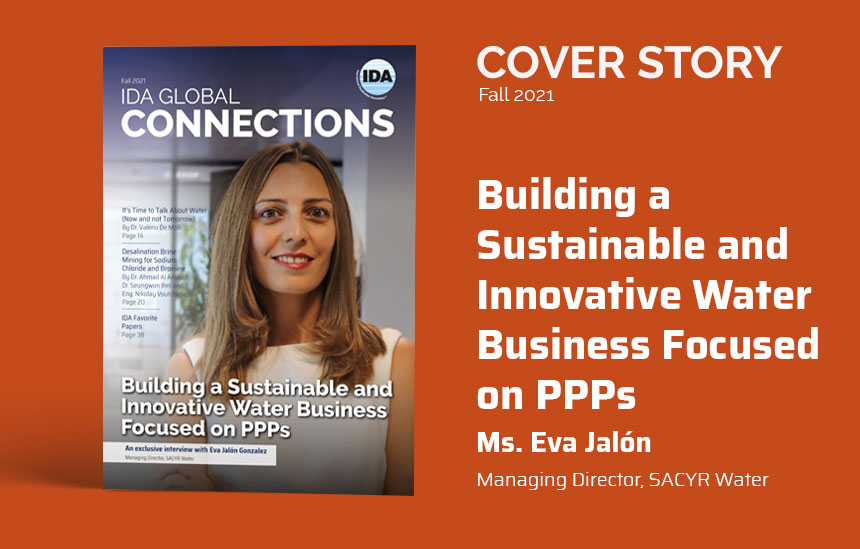Published on IDRA Global Connections Fall 2021 Issue
- An exclusive interview with Eva Jalón Gonzalez, Managing Director, SACYR Water
1. What brought you to the water sector?
After more than twenty years working in the civil infrastructure sector, firstly in the construction stage and then in the PPP sector for the last 15 years, I
assumed the general management of Sacyr Agua one year ago.
I have been with the Sacyr group for the last 14 years, where I have held different positions in all types of PPP management. Now, I am taking on the challenge of integrating Sacyr Agua into Sacyr Concessions as the water industry is strategic for our Group. We aspire to become a benchmark in applied technology, innovation, and project finance in water.
2. We are seeing a new generation of women CEOs in water companies in recent years; do you read this to signal a higher level and equal opportunity for women in this sector?
Indeed, every day there are more and more women working in traditionally male-dominated sectors such as water. Every step taken by women assuming positions of responsibility is an opportunity to achieve the longed-for gender equality, which gives us hope for the future. Companies like ours are promoting diversity and internal talent to move towards equality. For instance, in our 2021-2025 Strategic Plan, launched in February 2021, we have
set the goal of doubling the number of women managers in the Company.
3. What do you think are the main challenges facing the sector in the coming years?
Indeed, there are more than a few. First, to ensure access to safe drinking water and sanitation for everyone. Millions of people globally still lack access to these services, and all this requires adequate funding. Adequate legal framework and the involvement of the private sector through PPPs are also
necessary.
Another critical challenge for the following years is to develop sustainable agriculture from a perspective that takes water resources and energy into account: the estimation is that by 2050 we will have to double food production, which will demand more water consumption.
With all these growing demands and the effects of climate change, it is apparent that it will be necessary to have additional water resources produced through non-conventional solutions of desalination and reuse now growing worldwide very fast. It is also important that countries have common legislation promoting reuse, guaranteeing water quality, and protecting human health and the environment. Other technical challenges concerning microplastics and microbiology will require our attention in the coming years.
And, of course, all our actions should be sustainable, promoting the use of renewable energies and reducing the water footprint and CO2 emissions.
In our 2021-2025 Strategic Plan, we have set sustainability, innovation, and talent retention and attraction as the key values to achieve our objectives.
4. What regions are you most interested in, and where do you think we will see more growth in the application of desalination and reuse solutions?
In the coming years, the main actions will be to solve the problems of areas where there is currently a lack of water infrastructure. This includes the case
of Latin America and Africa and those countries with higher growth rates where greater water scarcity and restrictions on access to water can be expected, as is the case in the Gulf countries.
Sacyr has set its priority markets for this new strategic cycle and will strengthen its presence in those regions that are considered as “home markets”: Spain and Italy, in Europe; Colombia and Chile, in Latin America, and the English speaking markets: the USA, Canada, Australia, and the UK.
In addition, the company has defined other markets of interest, including Peru, Mexico, Portugal, Brazil, and the Nordic countries.
Of course, there are many other regions where water infrastructure actions, especially in desalination and reuse, are badly needed. Still, we are currently not interested in those countries or projects due to doubtful economic feasibility and high political risk.
This does not prevent us from ruling out any specific project that might interest us due to its technical characteristics or timeliness.
There is a global trend to continuously reduce water prices in PPPs, which is not compatible with the best quality in technical design, construction, and
operation.
5. With a strong focus on PPP projects, do you think these types of contract models can better help governments and industries solve water scarcity problems?
No doubt about it. The advantage of the PPP model is that it mitigates risks for the client, ensuring optimization in design, execution, and operation. In
Sacyr’s case, we additionally provide the differential advantage of intervening in the entire infrastructure value chain from project finance to design, construction, and operation.
6. The new Sacyr 2021-2025 Strategic Plan reinforces the company’s focus on PPP businesses and promotes sustainability as a key tool for the next five years. What do you think is the added value that the membership of industry associations such as IDA gives you and your company?
I think that sectorial and global associations like IDA promote the sustainable use of water resources (in this case, more focused on non-conventional
resources). It is also a meeting point for leaders, decision-makers, potential clients, and suppliers sharing knowledge and technology and detecting needs and markets for planning solutions. And of course, the active presence in conferences, seminars, etc., gives you visibility and the opportunity to share your experiences and knowledge.
7. How important are environmental aspects such as ensuring a circular economy, reducing the water-carbon footprint, implementing renewables, etc.?
It is a crucial part of our business decisions. In our case, we have a firm corporate commitment with measurable sustainability objectives such as reducing carbon and water footprint in all our activities.
8. Do you think we’re heading for a much more sustainable sector?
Of course. This is currently an essential condition to define the new projects, executive methods, operating way, and even the bankability of the projects.
9. What recommendations do you have to reach clean water security faster?
Firstly, sustainable management of scarce freshwater resources promotes water-saving and efficient use. All of them are complemented by the use of
non-conventional resources such as reuse and desalination. However, to achieve this, we should have a clear legal and economic framework regulating the minimum water quality parameters and making projects viable and sustainable. Another critical objective should be to have real-time monitoring and control systems that allow us to know the available quantity and quality of water and develop protocols of immediate actions in case of need.
10. What role do you think innovation and digitization can reduce water purification costs in the coming years?
This trend is unstoppable. Digitalization permeates all our activities and will lead to greater efficiency, effectiveness, and cost savings. Tools such as AI, IoT, Big Data, digital twins, Robotics, etc., have already entered our vocabulary and activities, and they are transforming the industrial sector positively.
11. What advice would you give to younger women working in the sector to establish a leadership role for themselves?
My main advice would be that we, women, must internalize that being a woman is not a limitation of any kind and that we need to be confident enough
to fight for our dreams and aspirations. I also believe that supporting other women through mentoring, for example, legal protection and the encouragement of senior management in companies and public administrations, is essential.




